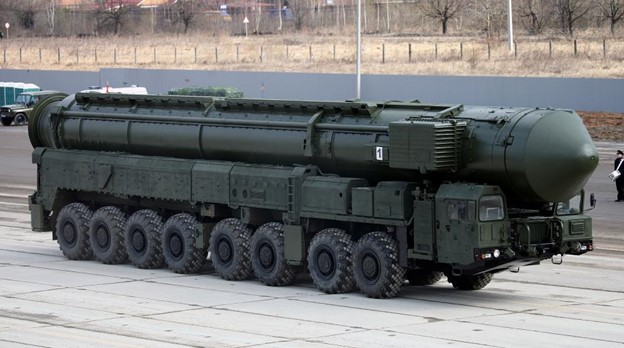Russia, which has the world’s most powerful nuclear arsenal, is emphasizing even further growth of its atomic weaponry.
According to Moscow’s semi-official news outlet RT “Russia will upgrade its nuclear arsenal as it is a primary guarantor of national security… President Vladimir Putin… revealed. We plan to further develop the nuclear triad as a guarantee of strategic deterrence and to preserve the balance of power in the world.”
Putin is also considering a revision to his announced doctrine to the doctrine that Russia’s nuclear doctrine that such weapons can only be used in the face of a threat to Russia’s sovereignty and territorial integrity”
According to the Office of the U.S. Director of National Intelligence “Russia will continue to modernize its nuclear weapons capabilities and maintains the largest and most diverse nuclear weapons stockpile. Moscow views its nuclear capabilities as necessary for maintaining deterrence and achieving its goals in a potential conflict against the United States and NATO, and it sees this as the ultimate guarantor of the Russian Federation. Russia’s inability to achieve quick and decisive battlefield wins, coupled with Ukrainian strikes within Russia, continues to drive concerns that Putin might use nuclear weapons. In 2023, Putin publicly touted his willingness to move nuclear weapons to Belarus in response to a longstanding request from Minsk. Moscow will continue to develop long-range nuclear-capable missiles and underwater delivery systems meant to penetrate or bypass U.S. missile defenses. Russia is expanding and modernizing its large and diverse set of nonstrategic systems, which are capable of delivering nuclear or conventional warheads, because Moscow believes such systems offer options to deter adversaries, control the escalation of potential hostilities, and counter U.S. and Allied conventional forces.”
The Arms Control Center reports that in 2023, Putin suspended it participation in the New Start nuclear treaty. According to the organization, this “merely confirmed what was already Russian policy… The United States determined that Russia was not in compliance with the treaty in January 2023. A State Department Spokesperson explained, Russia’s refusal to facilitate inspection activities prevents the United States from exercising important rights under the treaty and threatens the viability of US-Russian nuclear arms control.” In August 2022, the Kremlin blocked treaty-bound inspections visits to its facilities and in November 2022, Moscow postponed the treaty’s bilateral consultative commission.”
The anti-nuclear weapons organization ICAN (International Campaign to Abolish Nuclear Weapons) notes that “The question is on everyone’s mind- will he or won’t he? Will the taboo against nuclear use in war hold? … Since the invasion of Ukraine … Russian President Vladimir Putin has repeatedly violated international law. No one wants to believe that nuclear weapons will be used, but as long as nuclear weapons exist, they can be used. That is what nuclear deterrence is based on- credibly threatening to mass murder civilians with nuclear weapons…”
The Center for Strategic and International Studies (CSIS) explains that “Nuclear threats have been part of Russia’s strategy in Ukraine since the invasion in February 2022. The Kremlin clearly perceives some benefit from this strategy. One reason might be deterrence and nuclear signaling. But another reason Russia continues to rely on nuclear saber-rattling is because it is getting away with it. These risky behaviors are essentially cost-free to Moscow and have drawn little-to-no response from the wider international community, aside from statements of opprobrium by the United States and some European states. Reducing nuclear risks will require more countries to confront Russian nuclear saber-rattling, such as the latest drills, and impose diplomatic or economic costs.”
One reason why Putin feels confident in rattling his nuclear saber may be the diminished state of the American nuclear deterrent in the face of extraordinary challenges. Last year, Sen. John Kennedy (R-La) in a published article, worried that “we no longer face just one threat. Russia still maintains the world’s largest nuclear arsenal, but China’s nuclear stockpile is growing rapidly. North Korea continues to threaten our allies with its collection of nuclear weapons. And, thanks to the disastrous Iran nuclear deal, Iran is marching ever closer to developing nuclear weapons of its own. The United States must now counter nuclear superpowers in both China and Russia while also deterring the itchy trigger fingers of unstable dictators like Kim Jong Un and the Ayatollah in Iran. We should be innovating and preparing our nuclear arsenal for this new global dynamic, but instead, our nuclear stockpile remains stuck in the Cold War. Simply put: America’s nuclear stockpile is old and shrinking. And while modernizing our nuclear arsenal should be a top priority, our effort to restart nuclear weapon production has been riddled with delays and poor planning. And we don’t have time to waste. The United States has not built a single nuclear warhead since the close of the Cold War. Instead, we’ve focused on “life extension programs” to keep our old weapons operational by refurbishing them. “
